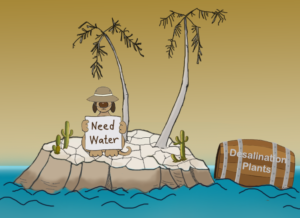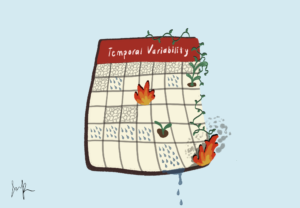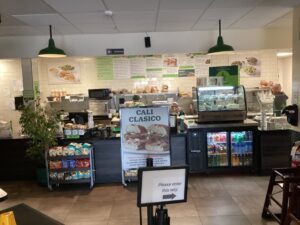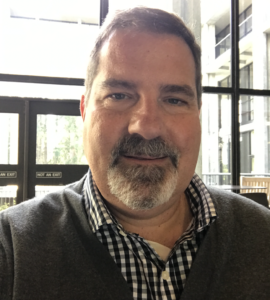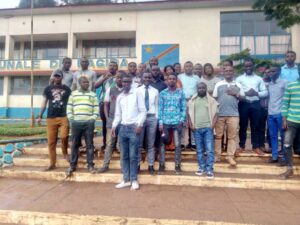
I had the opportunity to interview Kobi Weinberg. Kobi lives in London, where he moved earlier this year. He is the Impact Associate at the hedge fund Nephila Climate. He is also a Fellow and guest lecturer at Brown University and the Managing Editor of the Climate Tech VC newsletter. In this interview, Kobi offers his personal perspective and is not speaking on behalf of his firm.
First, could you tell me a little bit about yourself and how you got interested in
environmental work?
I grew up in Northbrook, Illinois, a suburb of Chicago. I have always enjoyed being outdoors and doing public service work. I spent several summers during high school working on farms and ranches. For example, I worked on an Oklahoma ranch that rehabilitates abused animals and on a Vermont farm that practices permaculture, a form of sustainable agriculture. These experiences made me feel closer to nature and ultimately led me to major in environmental science in college.
I was also lucky to have some cool internships during college. For example, I worked for a restaurant chain that was farm-to-table, meaning that it tried to use locally-sourced produce. Local food production is important because the food is usually fresher and because it does not burn fuel from transporting it across the country (or around the world). At the restaurant, I helped improve their catering and delivery operations. One benefit of the job is that I became friends with the chefs, who let me taste their newest creations.
At other jobs, I analyzed and recommended investments in technologies that can help address
climate change. For example, I explored whether firms could invest in phytoplankton (microscopic self-feeding ocean organisms) for their ability to suck in carbon from the atmosphere and in regenerative agriculture (a set of farming practices that aim to replenish soil with necessary nutrients).
What kind of jobs have you had since college?
Immediately after college, I worked for an organization that restores and preserves biodiversity habitats and wetlands. Some big projects, like wind farms, destroy the places where threatened species live. We helped build and preserve alternative habitats for those species.
Now, I am a climate specialist for a company called Nephila Climate. Our organization helps insure companies from risks of climate change and natural disasters. For example, we provide rainfall insurance to farmers around the world and fraud protection to buyers of forest preservation and restoration credits.
I also lecture at Brown about natural ecosystems and finance, and I write about climate technology startups for a newsletter called Climate Tech VC.
What was it like studying Environmental Science at Brown University?
Brown was a great place for me to learn. It has an “Open Curriculum,” which gives students significant flexibility in choosing courses and structuring their majors. For example, there was no major in sustainable agriculture and economics, so I created one by selecting the appropriate courses. I also took classes on development economics to learn about the economies of low- and middle-income countries. I was particularly interested in how these countries create food security– that is, how they ensure the consistent availability of nutritious food.
From these studies, I became interested in food insecurity in America. Tens of millions of Americans lack reliable access to a sufficient amount of healthy food. While government programs can help, the people receiving government support often have nutrition-deficient diets, for a variety of reasons. My senior thesis examined whether federal food assistance programs could encourage recipients to eat more healthy fresh food.
For the thesis, I worked with a local non-profit organization that hosts farmers’ markets throughout Rhode Island (where Brown is located). They have a program called Bonus Bucks. For every dollar in food assistance spent at a farmers’ market, Bonus Bucks gives the shopper another dollar to spend. Ultimately, I found the Bonus Bucks program provides does help beneficiaries get more healthy food.
Agriculture
Agriculture, such as animal agriculture, is the single largest source of methane emissions in
the United States and the second largest source of greenhouse gas emissions after fossil
fuels. And after reading your Agtech insights, your company addresses these issues. There
has been lots of controversy over whether to eat certain foods such as meat and fish. What
is your opinion on food choices in relation to carbon footprints, and what do you see as
solutions for the future?
Changes need to happen at a broader level. For example, governments need to restructure subsidies and incentives so that they encourage corporations to reduce food-linked emissions. In other words, financial and regulatory support from the government should benefit carbon-limiting practices (e.g., reducing plastic usage or incorporating local ingredients).
A person can also take many actions to lower the emissions associated with what they eat. For example, you can adopt a more plant-based diet to reduce meat consumption, use less plastic by taking your own containers to grocery stores, and limit your food waste by buying appropriate amounts of food (rather than supersizing the meal, for example). Another important step is buying locally produced food to limit the emissions associated with food transportation. These steps, if done collectively, can make a significant impact on the environment. Each person’s steps depend upon their circumstances, such as their finances, dietary restrictions, and cultural and religious beliefs.
What do you think of Beyond Meat, Impossible meats, and other plant-based meat
products? Do you think that is going to play a significant role in our future?
Meat alternatives are one option to reduce meat consumption. New alternatives are becoming available, such as meat grown in labs and food made from insects. All these products could play an increasing role in diets, especially as their costs decline and their tastes and textures resemble meat more closely. Still, there are questions about these products, beyond whether consumers will like them. For example, are they healthy, or at least healthier, than meat? One goal of a more plant-based diet is to have a healthier diet, so people may want to know that these products advance that goal. In addition, in their lifecycle – from production to distribution – how much do these products reduce emissions? Finally, do meat alternatives reduce the overall consumption of meat?
Adding on to this question of agriculture…
From a nature conservation and climate change standpoint, we need to encourage people to
eat more environmentally consciously. However, this can be difficult to implement,
especially in low socioeconomic communities. Some places, after all, depend on their source
of protein, such as fishing or cattle. Others will face problems with the prices of foods. This
begs the question: Is it more important to weigh the future of humans more importantly and consequently sacrifice the current generation? Or from an ethical standpoint, should we protect the people’s existence and lives today?
Your observation that low-income people bear a disproportionate burden from environmental problems is important. That is why topics like environmental justice have rightly become so prevalent in climate change discussions. A low-income person may not be able to easily make environmentally-friendly choices.
Regarding sacrifices, there is no question that people must make changes to protect the planet. These actions will help not just future generations but also ourselves. Previous generations have made sacrifices to safeguard people and principles they value. My grandfathers both fought in World War II and put their lives at risk to protect their families and democracy. We are not asking people to do that for the climate, but the same level of devotion and urgency for the cause is needed. In fact, many changes being asked of people today, such as limiting international travel or eating less meat, are minor. The longer we wait to act, however, the more significant the sacrifices will be. For example, the West has known for decades that it has a water problem. If this problem were addressed long ago, it would be less severe. Now, however, the steps needed will be more significant.
That was a great answer because it’s going to impact the low socioeconomic areas more
than the people who are in power and can change because they won’t be impacted as much.
Absolutely. Being wealthier often means you may have more options to avoid climate risks or lessen their impact. For example, a wealthy person who owns a house in a flood-prone area can afford to move where there is less flood risk, while a low-income person from the same area may be stuck there. The same principle applies to food too. Many people live in lower-income neighborhoods where few stores sell affordable and nutritious food. In these neighborhoods, called “food deserts,” the closest, and perhaps only, place to buy groceries might be a gas station, where food is expensive and no fresh produce is sold.
California Fires
I live in California, a state that, unfortunately, is growing infamous for its wildfires,
drought, and heat. Cutting down trees is one of the biggest ways to prevent wildfires.
However, trees provide numerous ecological services, the most important being the
sequestration of carbon dioxide and the production of oxygen. However, leaving trees will increase the chances of fire which end up releasing tons and tons of carbon. Should we cut
the trees?
The example you have given is particularly interesting. People frequently forget to examine a broader, critical consideration: forest health. Carbon sequestration is just one component to look at when assessing a forest.
If you have an acre of land and were trying to optimize for the amount of carbon sequestered, you will likely try to fit as many trees as possible in that acre. However, I believe that is a short-term mindset. If you want the forest to survive longer-term, trees should be more spread out. You need space between them so they are not competing for resources like water or sunlight. If the forested area gets too crowded, you likely also need to perform a level of thinning (i.e., cutting down branches). People even do prescribed burns to manage the density of weeds and other plants underneath the forest canopy.
The increasing incidence of forest fires has forced reconsideration of several policies, such as the burying of power lines, strategies for fighting fires, and cutting trees. Ultimately, cutting down trees, a practice the forest service uses, is one tool for managing wildfires. This policy has to be weighed against other factors, such as the benefits that trees provide.
What would you say to the citizens of California about what they can do on an individual
level?
Vote! Voting for political candidates and propositions that support environmental causes is the most powerful way to express your opinion on who should and how to manage wildfires. In addition, become a leader and speak out to bring attention to important environmental issues. There are many groups that can educate you about environmental issues and help you find a way to lend your voice to conservation efforts, even if you are too young to vote.
Future
What is your opinion on the emerging youth groups demanding climate action? For
example, Greta Thunberg and other young climate activists?
Greta Thunberg is an important voice for our generation because she raises awareness of climate change problems. Beyond simply speaking out, Greta has helped highlight that sacrifices are needed to limit emissions. Her sailing across the Atlantic Ocean in 2019 to attend conferences in New York City illustrates that. A roundtrip trip flight from London to New York generates almost 1000kg of carbon dioxide per passenger – or about 64kg per passenger per hour of flying. In terms of carbon emissions, this is equivalent to producing an iPhone 13 every hour you fly. Greta’s courageous journey, which would have been even longer than the provided example, shows that people, while they do not have to sail across the Atlantic, should consider alternatives to flying. Greta walks the walk and has model behavior for others to emulate.
What is something important you have learned in your profession?
I’ll mention three things. First, climate change is a complex problem. Petroleum products permeate our lives, from the gas in our cars to the plastic in disposable silverware. As a result, reducing our reliance on fossil fuels is hard. Second, high-level, big changes – the kind needed to address climate change – take time. I wish things moved faster in this area because we have such limited time to act before significant damage occurs. However, implementing change is time-consuming, difficult, and often frustrating. Third, having the facts on your side is not always enough to compel action.
The recent scientist rebellion has really shown us that scientists are getting worried that we
are not absorbing facts in the ways that we should be.
There is overwhelming evidence and scientific consensus about the damage that climate change causes and the steps we need to take, but many people refuse to hear or accept this information. Changing people’s behavior is not just about being logical; it is also about being persuasive. We need storytellers who can connect with folks of different backgrounds to persuade them to change.
What is your advice to the young generations who are serious about climate change as well
as social responsibility? Where should we focus, and what should we look for?
Climate change does not have to be your full-time focus for you to make a difference. Here are several things I’d recommend.
1. Push the organizations you interact with to change their systems. For example, you can lobby your school to limit their meat purchases or vote for politicians with specific environmental goals.
2. Stay informed about current and environmental events. So you do not get overwhelmed by emails, find one area that interests you, like cryptocurrency or art or video games.
3. If you want to participate more actively in climate projects, find communities of like-minded people in after-school clubs or regional nonprofits.
Thank you for doing this interview with us!


